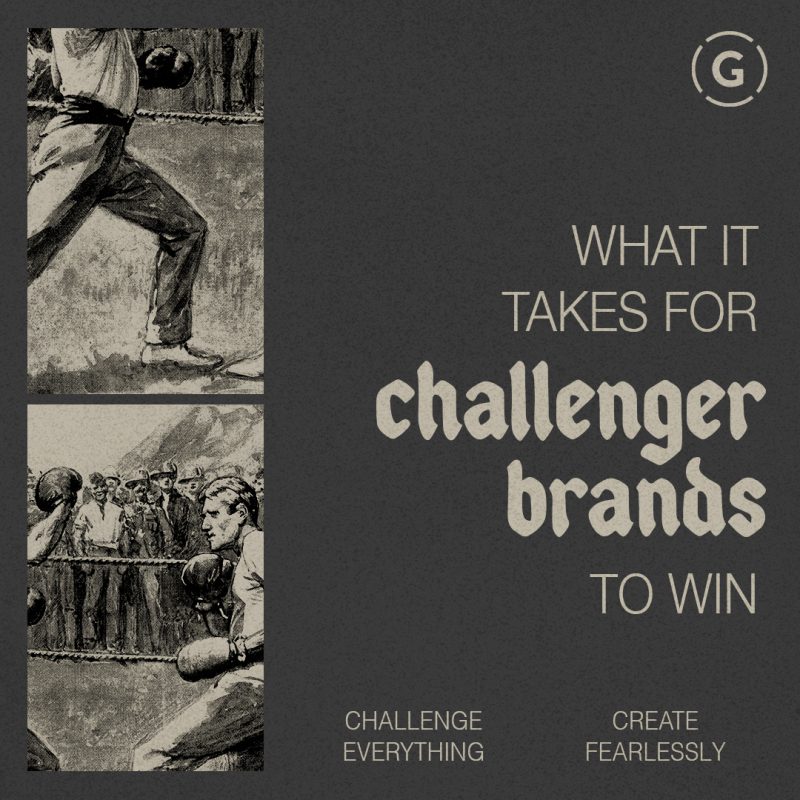We love challenger brands here at Gigasavvy, mostly because their principals line up so closely with our own. Challenger brands dare to think differently, and come to the table with creative solutions to meet their customers’ needs. We fully embrace this spirit with our own brand pillars, always striving to “Challenge Everything” as we seek to develop innovative brand strategies, marketing campaigns and creative executions.
In short, challenger brands boldly step out, confident in who they are and what they can achieve, regardless of what’s been done before, embracing any failure that may come as an opportunity to learn and grow. Challenger brands push the world forward.
Types of Challenger Brands
For those who are not deeply rooted in challenger brand culture, it may not be obvious that there are actually several different types of challenger brands:
Real and Human
It might be no surprise that we included this at the top of the list, since, here at Gigasavvy, we pride ourselves on being exactly this kind of challenger. Real & Human challenger brands seek to break away from the mold of impersonal, big-brand messaging that talks AT customers, to connect WITH consumers on a human level, like like Harry’s, who took on Gillette “with a small and idealistic group of people fighting to bring us something genuinely better.” These brands dig deeper into, not just what customers want and need, but why they need it, then take a fresh approach to marketing with a more conversational and storytelling style of advertising, embracing and addressing the real and imperfect human experience, in order to foster authentic 2-way communications.
Feisty Underdog
Challenger brands are often upstarts with few comparative resources, but a knack for positioning the established players’ size and strength as a liability. Feisty underdogs loudly broadcast their status as a David against industry Goliaths. Messaging is intentionally designed to highlight the contrast in “Little Guy” vs. “The Man,” or “Good” vs. “Evil” terms, so that they can inspire consumers to route for them and flock to provide support. When Ben and Jerry’s took on Haagen Dazs they were as feisty and scrappy as any ice cream brand could be, though they have since taken on Goliath status themselves.
Next Generation
Next Generation challenger brands recognize the importance of the shoulders on which they stand, the products that came before them, which they now iterate and modernize to meet the demands of the world today. They pay homage to the hard work that originally inspired them, or that gave them their start in the industry, while also highlighting that it is time to move forward with something better. In a perfect example of a Next Generation challenger brand campaign, Hyundai celebrates the evolution of the auto industry, which has notably said goodbye to many older stalwarts such as Plymouth, Pontiac and Oldsmbile, as a natural extension of the evolution of society at large.
Game Changer
As the name implies, these challenger brands forever change the landscape by approaching the market with a completely new perspective. They don’t just seek to take on established players within an industry, but to completely shake up the entire vertical. The most famous example here is when AirBnB completely revolutionized the hospitality industry with a simple premise of sharing vacant space in members’ homes.
Democratizer
Democratizing challenger brands seek to make products that had previously only been available to a select few, and make them available to everyone. E-commerce can often play a huge role in their success, as it allows these challenger brands to transcend physical borders. Food purveyor Goldbelly makes regional restaurant favorites available to consumers around the world, perfectly embodying this type of challenger brand.
People’s Champion
Similar to Democratizers, Peoples’ Champions are focused on making products more widely available, but, in this case, with a focus on bringing them to underserved, under-represented markets. One of our own clients is a beautiful example of this. Currently we are helping Radar Tires make premium tires more accessible to all consumers.
Missionary
These challenger brands are on a mission to make the world a better place, or right some wrong in the world with their new product, or new product messaging. In a campaign highlighting what cows, pigs and chickens would look like if they were allowed to live up to their ripe old age, Not Milk took a decidedly missionary brand challenger stance.
Irreverent Maverick
These challenger brands don’t just challenge the status quo, they poke you in the eye and say “Zoinks” while doing it. Irreverent Mavericks rely on often sarcastic humor to call attention to stale norms and highlight a new way of doing things. Dollar Shave Club, which was started by comedy student from the Upright Citizens Brigade, who had no actual experience manufacturing shaving products, is the ultimate example of how Irreverent Mavericks rely on humor to create success.
Enlightened Zagger
The name indicates that these challenger brands will zag while everyone else zigs. That is true, but not without thoughtful purpose. These Enlightened Zaggers will flip conventional rules that seemingly everyone knows and accepts as a truth on their heads, as was the case when Casper folded up a mattress and shipped it in a box, smaller than the average adult male — a previously inconceivable idea.
Visionary
Visionary challenger brands are not always recognized up front; it can often only be seen retrospectively. These brands are attributed with changing their category so much that it can actually end up creating a new category altogether. After struggling for years to make coffee that stood apart from competitors based on quality, Starbucks took a visionary brand challenger approach to coffee shops by creating “the third place” — a sanctuary between work and home where people could retreat to mingle, relax and recharge.
Benefits and Challenges of Being a Challenger Brand
When successful in their quest, challenger brands are recognized for making a difference in the hearts, minds and wallets of consumers. As we’ve seen above, in some cases, challenger brands forever change the landscape for the better by solving customer problems, making commerce more efficient, and creating products that address very real challenges in the world.
However, most challenger brands find that they must go up against very well established competitors, often with a lack of comparable resources. Even after the considerable operational and manufacturing hurdles with developing a new product or service have been cleared, these brands often find themselves facing behemoth competitive marketing budgets as well. They have to find ways to efficiently capture and keep audience attention in order to be successful.
Challenger Brand Marketing
By the very nature of their company culture, challenger brands usually take a scrappy approach to marketing. That does not necessarily mean that they don’t have a budget or won’t spend any money on advertising. In fact, some of the brands listed above gained notoriety through large broadcast TV ad buys, and even Super Bowl commercials. Being scrappy with your marketing means using resources wisely, often in unexpected ways, to get the maximum impact.
The key to getting maximum impact is to make sure you have a clear brand voice. Large, established players have often had their value propositions watered down over time as they’ve tried to appeal to the masses. Challenger brands are able to achieve success by very clearly communicating who they are, what they stand for, and how they plan to achieve their mission.
Once the brand position and voice clearly are defined, challenger brands have a strong position from which to stand as they bring their messaging to life. By taking a storytelling approach, these challengers can highlight how and why they are different, how that helps audiences solve problems in new and innovative ways, and why that matters. The most important thing is to develop creative that connects to audiences in a real and authentic way.
When the campaign creative is authentic and compelling, challenger brands have more clarity into how they can build and deploy marketing campaigns that will reinforce their narrative. For example, if the brand message is about disruption, guerilla marketing tactics that may make a lot of sense, while a strategy of cost domination would require a more traditional, far-reaching paid media campaign.
Strategic agency partners can help challenger brands to ask the right questions, figure out what they don’t know, and develop strategies that bring their brands to the market in the way that is the most aligned to the long term strategic vision.
Gigasavvy has experience helping challenger brands assess the landscape and position themselves for long-term success with comprehensive and adaptive brand strategies, meaningful brand stories, and award-winning marketing campaigns. Connect with us to chat about how we can help you drive your brand forward.



